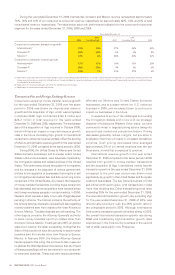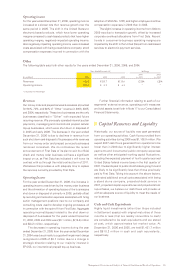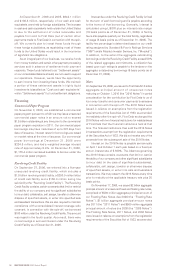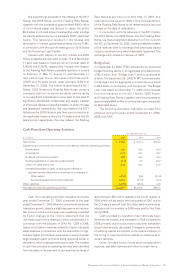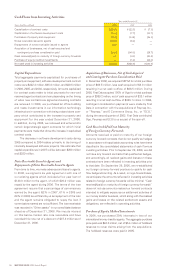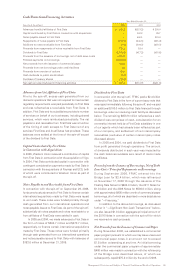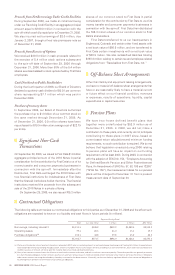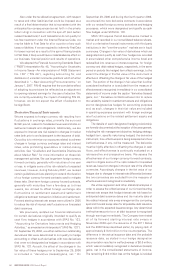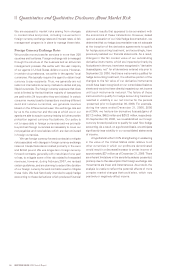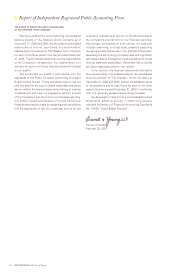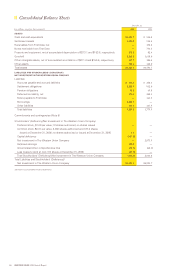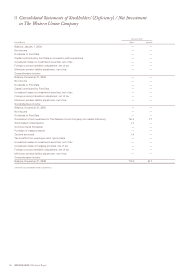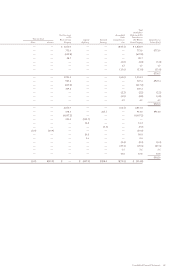Western Union 2006 Annual Report Download - page 60
Download and view the complete annual report
Please find page 60 of the 2006 Western Union annual report below. You can navigate through the pages in the report by either clicking on the pages listed below, or by using the keyword search tool below to find specific information within the annual report.WESTERN UNION 2006 Annual Report 58
Also under the tax allocation agreement, with respect
to taxes and other liabilities that could be imposed as a
result of a final determination that is inconsistent with the
anticipated tax consequences (as set forth in the private
letter ruling) in connection with the spin-off (and certain
related transactions) if such transactions do not qualify for
tax-free treatment under the Internal Revenue Code, we
may be liable to First Data for all or a portion of any such
taxes or liabilities. If we are required to indemnify First Data
for taxes incurred as a result of the spin-off being taxable
to First Data, it likely would have a material adverse effect on
our business, financial position and results of operations.
We adopted the Financial Accounting Standards Board
(“FASB”) interpretation No. 48, “Accounting for Uncertainty
in Income Taxes—An interpretation of FASB Statement
No. 109” (“FIN 48”), regarding accounting for, and
disclosure of, uncertain income tax positions which is further
described in “
—
New Accounting Pronouncements,” on
January 1, 2007. FIN 48 requires that the cumulative effect
of adopting its provisions be reflected as an adjustment
to opening retained earnings for the year of adoption. We
are currently evaluating the impact of adopting FIN 48,
however, we do not expect the effect of adoption to
be significant.
Derivative Financial Instruments
We are exposed to foreign currency risk resulting from
fluctuations in exchange rates, primarily the euro and
British pound, related to forecasted revenues and also on
settlement assets and obligations. Additionally, we are
exposed to interest rate risk related to changes in market
rates both prior to and subsequent to the issuance of debt.
Our policy is to minimize our exposures related to adverse
changes in foreign currency exchange rates and interest
rates, while prohibiting speculative or market-making
activities. See “Qualitative and Quantitative Disclosures
about Market Risk” for more information on these risk
management activities. We use longer-term foreign currency
forward contracts, generally with maturities of one year
or less, to mitigate some of the risk related to forecasted
revenues, however, during February 2007, we revised
certain guidelines and are planning to extend the duration
of our foreign currency forward contracts used to mitigate
these risks. Short-term foreign currency forward contracts,
generally with maturities from a few days up to three
weeks, are utilized to offset foreign exchange rate
fluctuations on settlement assets and settlement
obligations between transaction initiation and settlement.
Forward starting interest rate swaps were utilized in 2006
to reduce the risk of interest rate fluctuations on forecasted
debt issuances.
We previously restated our financial statements
for certain derivatives originally intended to qualify as
cash flow hedges in accordance with SFAS No. 133,
“Accounting for Derivative Instruments and Hedging
Activities,” as amended and interpreted (“SFAS No. 133”).
On September 29, 2006, we either settled our outstanding
derivatives that were determined to not qualify for hedge
accounting or offset such derivatives with new derivatives
that were not designated as hedges in accordance with
SFAS No. 133. As such, the effect of the changes in the
fair value of these hedges prior to September 29, 2006
is included in “derivative (losses)/gains, net.” On
September 29, 2006 and during the fourth quarter 2006,
we entered into new derivative contracts in accordance
with our revised foreign currency derivatives and hedging
processes, which were designated and qualify as cash
flow hedges under SFAS No. 133.
SFAS 133 requires that all derivatives be marked to
market and recorded in our consolidated balance sheets.
All of our derivative financial instruments with third party
institutions in the “over-the-counter” markets are in liquid
currencies. Changes in fair value of derivatives which are
designated and qualify as cash flow hedges are recorded
in accumulated other comprehensive income (loss) and
reclassified into revenue or interest expense, for foreign
currency and debt related hedges, respectively, in the same
period or periods the hedged item affects earnings, to the
extent the change in the fair value of the instrument is
effective in offsetting the change in fair value of the hedged
item. The portion of the change in fair value that is either
considered ineffective or is excluded from the measure of
effectiveness is recognized immediately in our consolidated
statements of income under the caption “derivative (losses)/
gains, net.” Derivative contracts entered into to reduce
the variability related to settlement assets and obligations
are not designated as hedges for accounting purposes
and, as such, changes in their fair value are included
in operating expenses consistent with foreign exchange
rate fluctuations on the related settlement assets and
obligations.
The details of each designated hedging relationship
are formally documented at the inception of the arrangement,
including the risk management objective, hedging strategy,
hedged item, specific risks being hedged, the derivative
instrument, how effectiveness is being assessed and how
ineffectiveness, if any, will be measured. The derivative
must be highly effective in offsetting the changes in cash
flows, and effectiveness is continually evaluated on a
retrospective and prospective basis. We assess the
effectiveness of our foreign currency forward contracts,
used to mitigate some of the risks related to forecasted
revenues, based on changes in the spot rate of the affected
currencies. Accordingly, changes in the fair value of our
hedges due to changes in interest rate differential between
the two currencies are excluded from the measure of
effectiveness and recognized immediately.
We utilize regression and other statistical analyses in
order to assess the effectiveness of our forward starting
interest rate swaps that hedge interest rate risk based on
anticipated debt issuance dates and the maturity date of
the related interest rate swap arrangement by comparing
spot and forward swap rates for all possible debt issuance
dates within the expected issuance range. Any determined
ineffectiveness prior to or at debt issuance is recognized
through earnings immediately. The Company terminated
all of its forward starting interest rate swaps in
November 2006 upon the issuance of the 2011 Notes
and the 2036 Notes described earlier, by paying cash of
approximately $18.6 million to the counterparties. The
difference in the actual issuance date and the probable
issuance date, as stated in our hedge designation
documentation resulted in ineffectiveness of $0.6 million,
which was immediately recognized in derivative (losses)/
gains, net in the consolidated statements of income.
The remaining $18.0 million loss on the hedges is included


